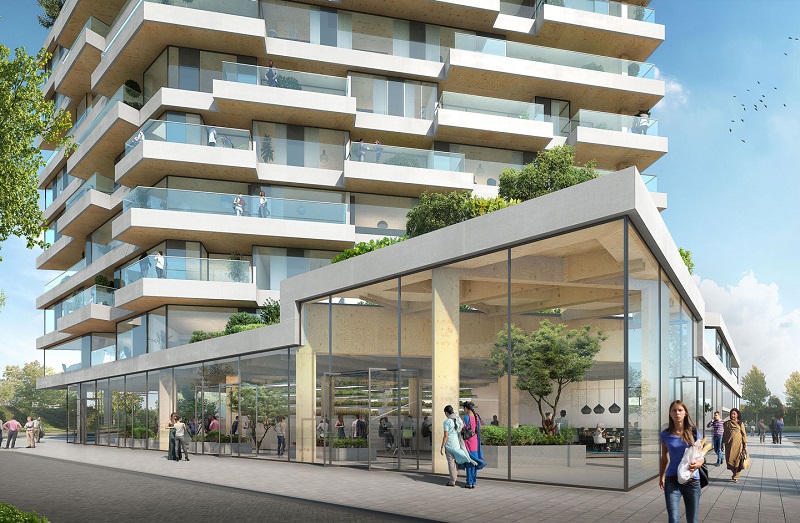HAUT, Amsterdam
On 20 July 2016, the municipality of Amsterdam selected Team V Architectuur to develop HAUT, the tallest timber tower in the world.
The 21-storey, 73 m, timber residential building will be located in Amstelkwartier, a new residential neighbourhood on the River Amstel, and will provide 55 apartments of different sizes.
The design is characterised by strong lines of light grey floor bands and tall windows, with cantilevering balconies arranged in an apparently random pattern. The timber ceilings below the balconies and the pronounced projections at the sharp building corner facing the River Amstel will add to HAUT’s distinctive appearance.
Team V Architectuur join other firms including ARUP, Lingotto and brand partner Netherlands Energy Company (NLE), to develop what is expected to be a prototype for building a timber high-rise in a sustainable and eco-friendly way.
The design of the tower is targeting a BREEAM Outstanding rating, the highest possible sustainability grade. The aim is for more than 3 million kg of carbon dioxide to be stored in the cross-laminated timber that is used to build HAUT. The design also includes energy-generating facades and wastewater collection and purification.
The name HAUT derives from ‘haute couture’ – tailor-made architecture. Residents of the high-rise will have considerable freedom of choice in terms of the apartment size, number of floors, lay-out and positioning of double height spaces, and balconies.
For more information, see HAUT.
Images and content courtesy of Team V Architectuur.
[edit] Find out more
[edit] Related articles on Designing Buildings Wiki
Featured articles and news
Latest Build UK Building Safety Regime explainer published
Key elements in one short, now updated document.
UKGBC launch the UK Climate Resilience Roadmap
First guidance of its kind on direct climate impacts for the built environment and how it can adapt.
CLC Health, Safety and Wellbeing Strategy 2025
Launched by the Minister for Industry to look at fatalities on site, improving mental health and other issues.
One of the most impressive Victorian architects. Book review.
Common Assessment Standard now with building safety
New CAS update now includes mandatory building safety questions.
RTPI leader to become new CIOB Chief Executive Officer
Dr Victoria Hills MRTPI, FICE to take over after Caroline Gumble’s departure.
Social and affordable housing, a long term plan for delivery
The “Delivering a Decade of Renewal for Social and Affordable Housing” strategy sets out future path.
A change to adoptive architecture
Effects of global weather warming on architectural detailing, material choice and human interaction.
The proposed publicly owned and backed subsidiary of Homes England, to facilitate new homes.
How big is the problem and what can we do to mitigate the effects?
Overheating guidance and tools for building designers
A number of cool guides to help with the heat.
The UK's Modern Industrial Strategy: A 10 year plan
Previous consultation criticism, current key elements and general support with some persisting reservations.
Building Safety Regulator reforms
New roles, new staff and a new fast track service pave the way for a single construction regulator.
Architectural Technologist CPDs and Communications
CIAT CPD… and how you can do it!
Cooling centres and cool spaces
Managing extreme heat in cities by directing the public to places for heat stress relief and water sources.
Winter gardens: A brief history and warm variations
Extending the season with glass in different forms and terms.
Restoring Great Yarmouth's Winter Gardens
Transforming one of the least sustainable constructions imaginable.



























